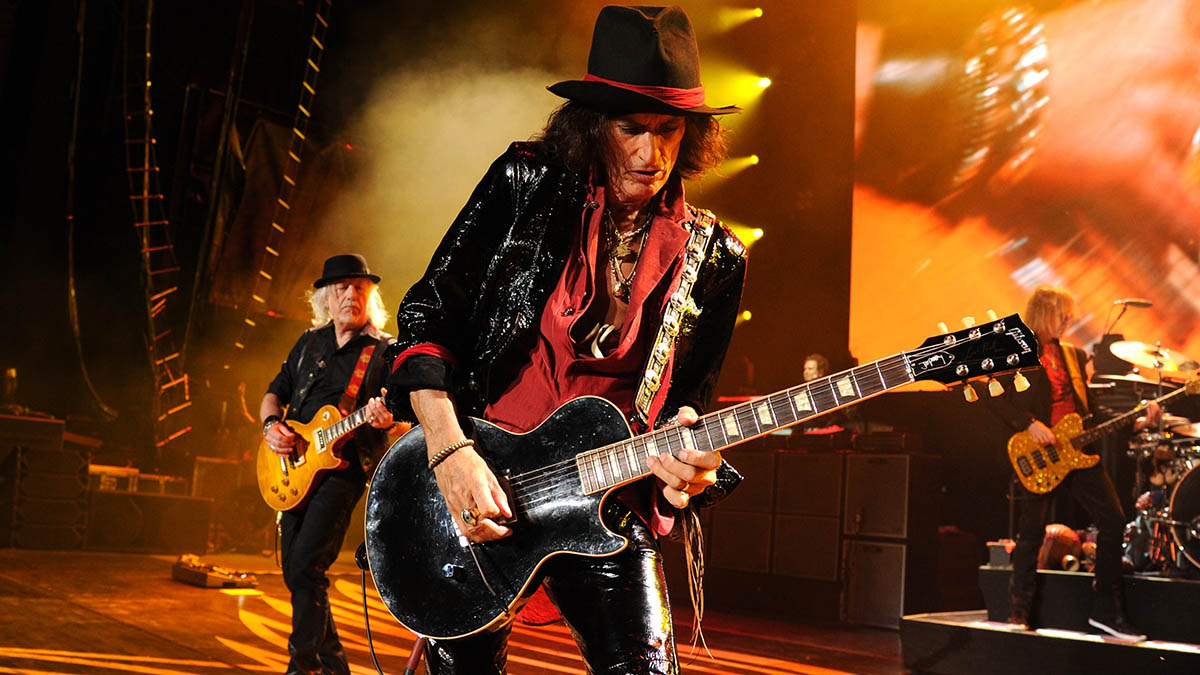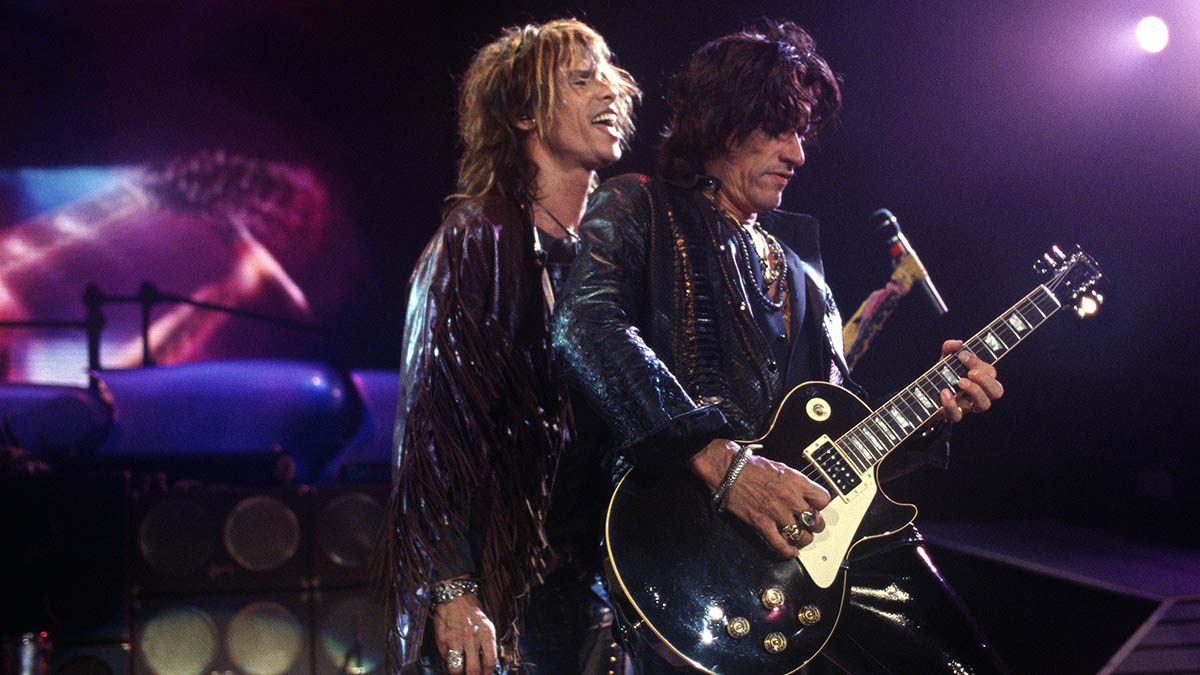
Aerosmith’s Joe Perry has a long and close association with Gibson Les Pauls. Just as Jeff Beck was the inspiration for Joe to play a Les Paul, so Joe was the inspiration for Slash to play one. And in partnership with Gibson, Joe now has four signature models to his name.
In Aerosmith’s early career, it was the band’s other guitarist, Brad Whitford, who mostly recorded with a Les Paul while Joe played a Stratocaster for contrast. As Joe tells TG: “I have a lot of guitars.” But wherever he is, he always has a Les Paul close by...
What are some classic Aerosmith songs where you played a Les Paul?
“I was just reading a John Lennon interview and he was like, ‘I don’t know about strings. We just used whatever was on there!’ Obviously he was more concerned about the music and writing the songs. In some ways I can identify with that. I was more concerned about writing songs than I was about the particulars of which amp I used or whatever.
“That said, I would say with a fair amount of confidence I used a Les Paul on Eat The Rich [1993], Toys In The Attic [1975], Pandora’s Box [1974] and Nine Lives [1997]. I would bet that at least one of my tracks on Walk This Way [1975] is a Les Paul, and then everything I did after that was with the Strat. Back then Brad [Whitford] was a hardcore Les Paul player.
“He doesn’t change guitars all that much. Even if we’re doing a song in an open tuning, he’ll figure it out in standard. I always felt like having a different voice in there worked really well for different parts, rather than just playing in unison.”
What made you start playing Les Pauls?
“After seeing that Jeff Beck played a Les Paul, I determined to sell the Guild Starfire I had. I traded it in ’68. They had just reissued the Les Paul Gold Top and so I bought a new one. I could have picked up a ’59 for pretty close to what I paid for a new one off the wall, but I just went into the music store and there it was.
“I played Les Pauls pretty much throughout the ’70s, but I recorded most of my stuff with Strats. I always loved having the vibrato arm, and it seemed easier to get different tones out of a Strat. The tone you could get out of a Les Paul was heavier and it was easier to get to get distortion with less noise.
“I think a lot of the reason that guitar plays so well in general is because it has its roots in Spanish guitar. The first version, with the trapeze tailpiece and the strings going under the bridge, is almost impossible to play the way we play guitar now, but after the first couple of years they really nailed it.”
What made your tobacco burst ’59 so special?
“I’ll play all night and but when I pick up the ’59... Some of the reissues really have that feel but it’s hard to replicate 50 or 60 years of playing. The wood they used was more than likely old growth trees. It’s a combination of so many things and they just got it right. I have a lot of different guitars obviously, but if I’m going to be in one place for a long time I have a very short list of what I’ve got to have. Obviously there’s a Les Paul.
“I have Les Pauls from all the different eras. When I pick up a Les Paul, it just feels right in every way, if it’s the right Les Paul. I mean, when I go to pick up the ’59 – I’ve played two or three of the reissues and if I’d never had the chance to play a ’59, whatever else would work. In my house I have, like, six guitars in a row.
I’ve played some ’59 Les Pauls that frankly didn’t feel that good or sound that good
“When I pick up that Les Paul, the neck is just right, the radius across the fretboard. It’s just an amazing thing they stumbled on. Some people probably don’t like that really thick neck in the early ones. I preferred that. Over the years, my hands have started to show the wear. Now I have to go with a little bit thinner neck, but certainly not like a 1960. I always liked that heavier neck compared to a Strat. Les Paul and Gibson just hit the nail on the head.”
Do you modify your Les Pauls?
“Back in the ’70s when I was looking for higher-output guitars I’d change the pickups. I wasn’t the only one, that’s for sure. Not that they’re bad – Bill Lawrence and Barcus Berry made some really good pickups. But now so many of us are opening cases of guitars from that era, and you just close your eyes and hope that the old pickups are in there.
“There are a bunch where I’ve opened that little compartment and there was nothing in there but moths and air. You wonder where those pickups went! At least I never did it with PAFs.”
Do you think vintage Les Pauls are the best?
“I’ve played some ’59 Les Pauls that frankly didn’t feel that good or sound that good. As an investment they’re always going up, but I’ve had the chance to play two or three side by side and some of them don’t sound the same as the others. I won’t say they sound bad because I don’t think there is a bad-sounding guitar.
“I think every guitar has a voice in it, has a place that somebody can use it – ask Jack White! That’s why I keep up to date with the new stuff. There’s a song in every guitar. But to just sit down and play for your own fun, there’s something about a Les Paul that just feels right.”

Your first signature Les Paul was the blackburst you played in the film Wayne’s World 2. What features did you want that guitar to have?
“I’ve done four guitars with Gibson. We had the blackburst, the Boneyard tiger stripe, the replica of the ’59 Tobacco Burst, and the Gold Rush. The first signature model was a blackburst, a black sunburst. It’s got the tonex in it, a push-pull pot which is the wah part of a wah-wah pedal. When you pop that out you can set it at a cool spot and it’ll cut through whatever for a solo.
“I was working with Chandler Guitars and they had this aftermarket tone pot that I wanted to put in the signature model. I don’t know if they’re on the market anymore. I still have a few in the box that I was able to snag.
“I wouldn’t be surprised if a lot of people that have those guitars don’t know it. I’ve talked to people and they said, ‘Really, it’s got that?’ That was a great thing for soloing. You can hold a note and get some sustain, or change the tone in the middle of a solo.”
Your next signature was the Boneyard, with the tiger stripe flame.
“I wanted to do something a little different, something that you really hadn’t seen. I was trying to describe what I wanted, and my wife Billie, said “Why don’t you do this contrasting stripe?” They said ‘We don’t think that’ll work.’ She’s an artist and painter, so she actually went in and took a blank piece of maple that had a really nice grain, she painted it like she would do on a canvas.
“She made it work, and it the grain just jumped out. So she came up with that finish. There are so many different iterations of Les Pauls. That one just had what I what I really liked about them: the neck, the pickups not being extremely high-output, all that. They even did an Epiphone version, which was really nice.”
You’ve got a Goldtop Les Paul with one pickup and a Wilkinson tremolo. What’s the story there?
“After I quit Aerosmith for a while, in 1979, and then Brad left in 1981, he came down to the studio when we were working on the last Joe Perry Project record. He brought a Les Paul with them that he’d played in Aerosmith when they wanted him to play a Stratocaster. He took one of the pickups out and he contoured the body. I don’t know if he’d put a whammy bar on it or not, but I played the guitar and it really felt good.
“It had been well played, had a lot of a lot of miles on it and it really had a really nice feel to it. I said, ‘Maybe they can make me something like that.’ Eventually [in 2019] we did a run called the Gold Rush. It’s a little bit narrower body. It’s got the contour on the back, and it’s a single pickup and a Strat-type bridge.
“They did a gold and a black one for me and I really like both of them. I think we did one without a tone control, and one with the tonex in it – like I said, I had a couple left. It wasn’t unique, you know, there were a lot of people who’ve done you know single pickup Les Paul kind of things. But that is one I play a lot on stage.”







